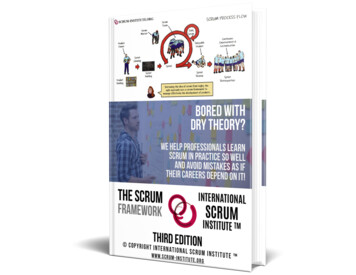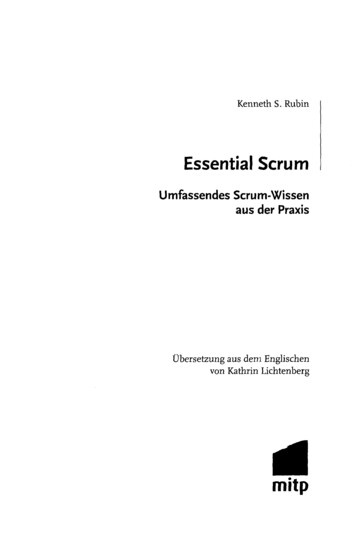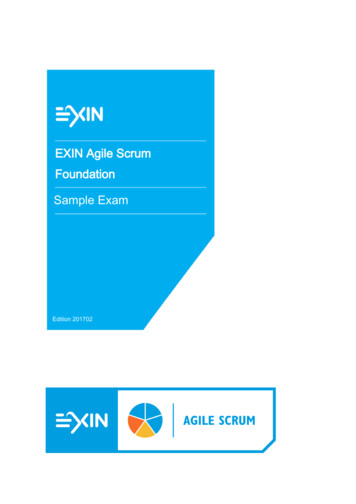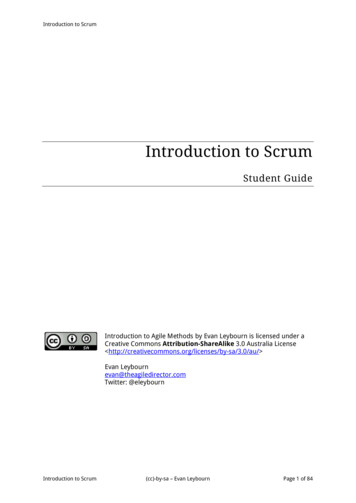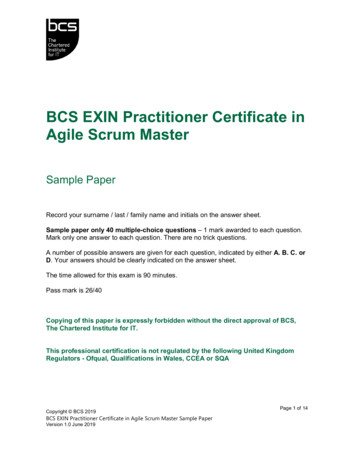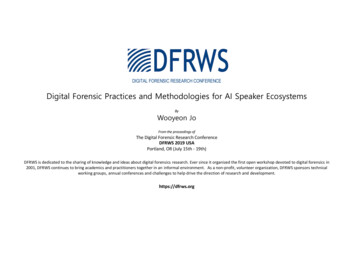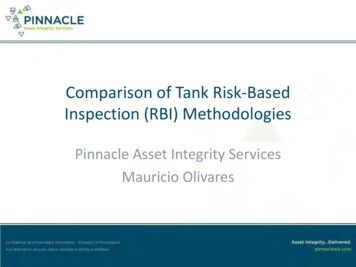
Transcription
Agile MethodologiesXP and ScrumIntroduction into Software EngineeringLecture 22Bernd BrueggeApplied Software EngineeringTechnische Universitaet Muenchen 2009 Bernd BrueggeSoftware Engineering Winter 2008-91
Problem: How to we Control SoftwareDevelopment?How can software development best be described? Two opinions: Maturity vs agility1.Through organizational maturity (Humphrey) Repeatable process, Capability Maturity Model (CMM)2.Through agility (Schwaber): Large parts of software development is empirical in nature;cannot be modeled with a defined processHow do we control software development? Software development is a deterministic process with a defined process control model Software development is a nondeterministic process with an empirical process control model. 2009 Bernd BrueggeSoftware Engineering Winter 2008-92
Defined Process Control Model The defined Process control models assumes thatsoftware development is a deterministic process Given a well-defined set of inputs, the same outputs aregenerated every time Deviations are seen as errors that need to be corrected All activity-oriented software lifecycle modelsintroduced in the previous lecture are defined processcontrol models Precondition to apply the defined process controlmodel: Every piece of work can be completely understood All the activities and tasks are well defined to providerepeatability and predictability If the preconditions are not satisfied: Lot of surprises (often too late), loss of control,incomplete or wrong work products. 2009 Bernd BrueggeSoftware Engineering Winter 2008-93
Empirical Process Control ModelThe empirical process control model assumes thatmany aspects of software development arebetter described as a nondeterministic process Not all pieces of work need to be completelyunderstood or can be understood Deviations are seen as opportunities that need to beinvestigated The empirical process “expects the unexpected” Control is exercised through frequent inspection Daily inspection in Scrum Conditions when to apply this model: Frequent change is expected during the project, inputsare unpredictable and outputs are unrepeatable. 2009 Bernd BrueggeSoftware Engineering Winter 2008-94
Outline of the Lecture Two examples of empirical process controlmodels Extreme Programming (XP) Scrum Both are also examples of agile methodologies Agile methodologies use an empirical process model todescribe the software lifecycle. 2009 Bernd BrueggeSoftware Engineering Winter 2008-95
Issues to be addressed by a Methodology(See Lecture 2) Methodologies provide guidance, generalprinciples and strategies for selecting methodsand tools in a given project environment Key questions for which methodologies provideguidance: HowHowHowHowHowHowmuchmuchmuchmuchmuchmuch 2009 Bernd Brueggeinvolvement of the customer?planning?reuse?modeling before coding?process?control and monitoring?Software Engineering Winter 2008-96
XP (Extreme Programming) XP assumes that change is normal XP assumes that software developer must be able reactto changing requirements at any point during a project XP is an agile software methodology because It places higher priority on adaptability (“empiricalprocess control model”) than on predictability (“definedprocess control model”) XP prescribes a set of day-to-day practices formanagers and developers to address change. 2009 Bernd BrueggeSoftware Engineering Winter 2008-97
History of XP Original cast of contributors Kent Beck, Ron Jeffries, Ward Cunningham (alsocreated Wiki) Application of XP in the Chrysler ComprehensiveCompensation project (C3 Project) in 1995 Lots of initial excitement but later a lot ofproblems: Daimler actually shut down the C3 Project in 2000 andeven banned XP for some time See Additional References. 2009 Bernd BrueggeSoftware Engineering Winter 2008-98
XP Day-to-Day Practices1. Rapid feedback Confronting issues early results in more time forresolving issues. This applies both to client feedbackand feedback from testing2. Simplicity The design should focus on the current requirementsSimple designs are easier to understand and changethan complex ones3. Incremental change One change at the time instead of many concurrentchangesOne change at the time should be integrated with thecurrent baseline. 2009 Bernd BrueggeSoftware Engineering Winter 2008-99
XP Mantras (continued)4. Embracing change Change is inevitable and frequent in XP projects Change is normal and not an exception that needs tobe avoided5. Quality work Focus on rapid projects where progress isdemonstrated frequently Each change should be implemented carefully andcompletely. 2009 Bernd BrueggeSoftware Engineering Winter 2008-910
How much planning in XP? Planning is driven by requirements and theirrelative priorities Requirements are elicited by writing stories with theclient (called user stories) User stories are high-level scenarios or use casesthat encompass a set of coherent features Developers decompose each user story in terms ofdevelopment tasks that are needed to realize the story Developers estimate the duration of each task in termsof days If a task is planned for more than a couple of weeks, itis further decomposed into smaller tasks. 2009 Bernd BrueggeSoftware Engineering Winter 2008-911
How much planning in XP? Ideal weeks Number of weeks estimated by a developer toimplement the story if all work time was dedicated forthis single purposeFudge Factor Factor to reflect overhead activities (meetings, holidays,sick days. ) Also takes into account uncertainties associated withplanningProject velocity Inverse of ideal weeks i.e., how many ideal weeks can be accomplished infixed time. 2009 Bernd BrueggeSoftware Engineering Winter 2008-912
How much planning in XP? (2) Stacks The user stories are organized into stacks of relatedfunctionality Prioritization of stacks The client prioritizes the stacks so that essentialrequirements can be addressed early and optionalrequirements last Release Plan Specifies which story will be implemented for whichrelease and when it will be deployed to the end user Schedule Releases are scheduled frequently (e.g., every 1–2months) to ensure rapid feedback from the end users. 2009 Bernd BrueggeSoftware Engineering Winter 2008-913
Team Organization in XP Production code is written in pairs (pairprogramming) The person typing is called the driver. The person reviewing the code is called the observer ornavigator. Individual developers may write prototypes forexperiments or proof of concepts, but notproduction code Pairs are rotated often to enable a betterdistribution of knowledge throughout the project The two programmers switch roles frequently, possiblyevery 30 minutes. 2009 Bernd BrueggeSoftware Engineering Winter 2008-914
How much reuse in XP? Simple design Developers are encouraged to select the most simplesolution that addresses the user story being currentlyimplemented No design reusability The software architecture can be refined anddiscovered one story at the time, as the prototypeevolves towards the complete system Focus on Refactoring Design patterns might be introduced as a result ofrefactoring, when changes are actually implemented Reuse discovery only during implementation. 2009 Bernd BrueggeSoftware Engineering Winter 2008-915
How much modeling in XP? No explicit analysis/design models Minimize the amount of documentation Fewer deliverables reduce the duplication of issues Models are only communicated amongparticipants The client is the “walking specification” Source Code is the only external model The system design is made visible in the source codeby using descriptive naming schemes Refactoring is used to improve the source code Coding standards are used to help developerscommunicate using only the source code. 2009 Bernd BrueggeSoftware Engineering Winter 2008-916
How much process in XP? Iterative life cycle model with 5 activities:planning, design, coding, testing and integration Planning occurs at the beginning of each iteration Design, coding, and testing are done incrementally Source code is continuously integrated into the mainbranch, one contribution at the time Unit tests for all integrated units; regression testing Constraints on these activities Write the tests first. Unit tests are written before units.They are written by the developer Generalized to test-driven programming Catch the errors: When defects are discovered, anotherunit test is created to reproduce the defect Refactor before extending the source code. 2009 Bernd BrueggeSoftware Engineering Winter 2008-917
How much control in XP? Reduced number of formal meetings Daily stand up meeting with the co-located client forstatus communication No discussions to keep the meeting short No inspections and no peer reviews Pair programming is used instead Production code is written in pairs, review duringcoding. Self-organizing system with a leader: The leader communicates the vision of the system The leader does not plan, schedule or budget The leader establishes an environment based oncollaboration, shared information, and mutual trust The leader ensures that a product is shipped. 2009 Bernd BrueggeSoftware Engineering Winter 2008-918
Summary of the XP MethodologyPlanning Co-locate the project with the client, write user storieswith the client, frequent small releases (1-2 months),create schedule with release planning, kick off aniteration with iteration planning, create programmerpairs, allow rotation of pairsModeling Select the simplest design that addresses the currentstory; Use a system metaphor to model difficultconcepts; Use CRC cards for the initial objectidentification; Write code that adheres to standards;Refactor whenever possibleProcessCode unit test first, do not release before all unit testspass, write a unit test for each uncovered bug, integrateone pair at the timeControl Code is owned collectively. Adjust schedule, Rotatepairs, Daily status stand-up meeting, Run acceptancetests often and publish the results. 2009 Bernd BrueggeSoftware Engineering Winter 2008-919
Introduction Classical software development methodologieshave some disadvantages: Huge effort during the planning phase Poor requirements conversion in a rapid changingenvironment Treatment of staff as a factor of production Agile Software Development Methodologies Minimize risk short iterations Real-time communication (preferable face-to-face) very little written documentation www.agilealliance.org 2009 Bernd BrueggeSoftware Engineering Winter 2008-920
Today’s Lecture MiscellaneousWhat is Scrum?Agile Alliance and ManifestoHistory of ScrumDefinitionComponents of Scrum Scrum Roles The Process Scrum Artifacts Conclusion 2009 Bernd BrueggeSoftware Engineering Winter 2008-921
Miscellaneous Next Thursday: 8:15-10:00 HS2 , Sprechstunde(“doctor’s hour”) Final Exam 5 February 2009, Maschinenwesen 0001, 18:00-19:30 Repeat exam 23 April, Location: TBA, Time: TBA Note: Repeat exam means Repeat exam Next Tuesday: Invited Lecture iPhone Praktikum Summer 2009 2009 Bernd BrueggeSoftware Engineering Winter 2008-922
Tuesday 16:15-18:00Invited LectureWarum IT-Projekte scheiternKlaus Eberhardt, iteratec GmbH3. Februar 2009 2009 Bernd BrueggeSoftware Engineering Winter 2008-923
iPhone Praktikum Announcement SS 2009 2009 Bernd BrueggeSoftware Engineering Winter 2008-924
Manifesto for Agile Software Development http://www.agilemanifesto.org/ Individuals and interactions are preferred overprocesses and tools Working software is preferred overcomprehensive documentation Customer collaboration over contract negotiation Responding to change over following a plan. 2009 Bernd BrueggeSoftware Engineering Winter 2008-925
History of Scrum 1995: Jeff Sutherland and Ken Schwaber analyse commonsoftware development processes Conclusion: not suitable for empirical, unpredictableand non-repeatable processes Proposal of Scrum Enhancement of Scrum by Mike Beedle Combination of Scrum with Extreme Programming 1996: Introduction of Scrum at OOPSLA 2001: Publication “Agile Software Developmentwith Scrum” by Ken Schwaber & Mike Beedle Founders are also members in the Agile Alliance. 2009 Bernd BrueggeSoftware Engineering Winter 2008-926
Scrum Definition (Rugby): A Scrum is a way to restartthe game after an interruption, The forwards of each side come together in a tightformation and struggle to gain possession of theball when it is tossed in among them Definition (Software Development): Scrum is anagile, lightweight process To manage and control software and productdevelopment with rapidly changing requirements Based on improved communication and maximizingcooperation. 2009 Bernd BrueggeSoftware Engineering Winter 2008-927
Why Scrum ?Traditional methodsare like relay races 2009 Bernd BrueggeAgile methods arelike rugbySoftware Engineering Winter 2008-928
Practicing a Scrum 2009 Bernd BrueggeScrums in Real GamesSoftware Engineering Winter 2008-929
Testudo:Battle Formation used by the Romans 2009 Bernd BrueggeSoftware Engineering Winter 2008-930
Methodology Issues Methodologies provide guidance, generalprinciples and strategies for selecting methodsand tools in a given project environment Key questions for which methodologies provideguidance: HowHowHowHowHowHowmuchmuchmuchmuchmuchmuch 2009 Bernd Brueggeinvolvement of the customer?planning?reuse?modeling before coding?process?control and monitoring?Software Engineering Winter 2008-931
Scrum as Methodology Involvement of the customer Onsite customer Planning Checklists and incremental daily plans Product backlog, sprint backlogs Reuse Checklists from previous projects Modeling Models may or may not be used Process Iterative, incremental p
Scrum Definition (Rugby): A Scrum is a way to restart the game after an interruption, The forwards of each side come together in a tight formation and struggle to gain possession of the ball when it is tossed in among them Definition (Software Development): Scrum is an agile, lightweight process
